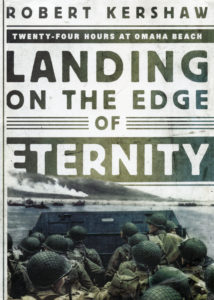
Most World War II devotees are familiar with the visceral depiction of the carnage on Omaha Beach from the D-Day invasion scene of the classic war movie Saving Private Ryan. In his new book, Landing on the Edge of Eternity, British Army veteran Robert Kershaw has provided more than 300 pages of similarly gripping narrative. The author bases his version of events mostly on published memoirs and military unit accounts, so there is little new here for knowledgeable readers. But he portrays very well the bloody chaos that reigned from the Colleville cliffs to Pointe du Hoc along the Normandy coast on June 6, 1944.
This work provides myriad perspectives, from privates to generals on both the American and German sides, to the testimonies of the French civilians caught in the middle. The book begins with accounts of lost paratroopers dropped miles from their respective targets and German troops defending themselves in half-built fortifications against Allied forces; moves to the naval bombardment of the shore and the dangerous ride of assault craft along the beaches; depicts the floundering early waves of the Allied landings and their bold assault up Pointe du Hoc; and finally describes their eventual move inland.
Readers will enjoy immersive text that will make them feel almost firsthand what it was like to endure massive naval gunfire, man machine guns decimating landing craft, climb steep cliffs under fire, and experience the deadly confusion on the beaches. Kershaw describes the fighting on the ground and even in the air, as the Luftwaffe launched a few sorties toward the beaches amid swarms of Allied fighters.
One of the most interesting accounts is that of famous photographer Robert Capa, who captured so many of the iconic images of the day. The author describes the battle experiences of many of Capa’s subjects beyond just photographic images frozen in time. One example is that of the wounding of Private First Class Huston “Hu” Riley, immortalized by Capa as he swims through beach obstacles, pushing his inflatable lifebelt ahead of him.
The final results of that bloody amphibious assault were decided by a multitude of individual actions ranging from courage to cowardice with much in between. The First Duke of Wellington, Arthur Wellesley, once compared writing a history of a battle to that of a boisterous formal ball, with participants remembering small events without really being able to truly grasp their value or importance. By applying a broader perspective, Kershaw reveals how the mosaic pieces of violence on Omaha Beach eventually produced a picture of victory for the Americans who sacrificed so much there. —Conrad Crane is the chief of historical services for the U.S. Army Heritage and Education Center at Carlisle Barracks, Pennsylvania, and a former professor of history at West Point.✯





